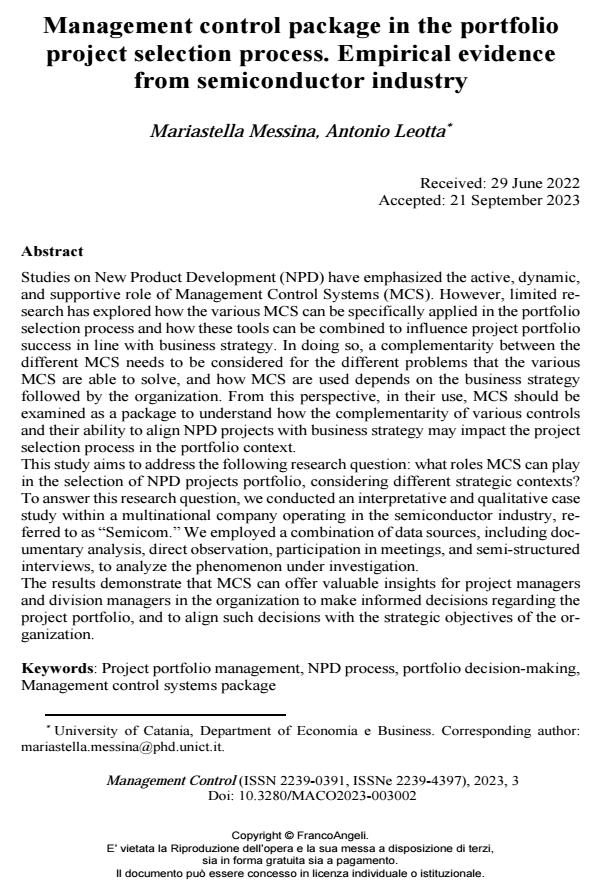Management control package in the portfolio project selection process. Empirical evidence from semiconductor industry
Titolo Rivista MANAGEMENT CONTROL
Autori/Curatori Mariastella Messina, Antonio Leotta
Anno di pubblicazione 2024 Fascicolo 2023/3
Lingua Inglese Numero pagine 18 P. 25-42 Dimensione file 282 KB
DOI 10.3280/MACO2023-003002
Il DOI è il codice a barre della proprietà intellettuale: per saperne di più
clicca qui
Qui sotto puoi vedere in anteprima la prima pagina di questo articolo.
Se questo articolo ti interessa, lo puoi acquistare (e scaricare in formato pdf) seguendo le facili indicazioni per acquistare il download credit. Acquista Download Credits per scaricare questo Articolo in formato PDF

FrancoAngeli è membro della Publishers International Linking Association, Inc (PILA)associazione indipendente e non profit per facilitare (attraverso i servizi tecnologici implementati da CrossRef.org) l’accesso degli studiosi ai contenuti digitali nelle pubblicazioni professionali e scientifiche
Studies on New Product Development (NPD) have emphasized the active, dynam-ic, and supportive role of Management Control Systems (MCS). However, limited research has explored how the various MCS can be specifically applied in the port-folio selection process and how these tools can be combined to influence project portfolio success in line with business strategy. In doing so, a complementarity be-tween the different MCS needs to be considered for the different problems that the various MCS are able to solve, and how MCS are used depends on the business strategy followed by the organization. From this perspective, in their use, MCS should be examined as a package to understand how the complementarity of var-ious controls and their ability to align NPD projects with business strategy may im-pact the project selection process in the portfolio context. This study aims to address the following research question: what roles MCS can play in the selection of NPD projects portfolio, considering different strategic con-texts? To answer this research question, we conducted an interpretative and quali-tative case study within a multinational company operating in the semiconductor industry, referred to as “Semicom.” We employed a combination of data sources, including documentary analysis, direct observation, participation in meetings, and semi-structured interviews, to analyze the phenomenon under investigation. The results demonstrate that MCS can offer valuable insights for project manag-ers and division managers in the organization to make informed decisions regard-ing the project portfolio, and to align such decisions with the strategic objectives of the organization.
Parole chiave:Project portfolio management, NPD process, portfolio decision-making, Management control systems package
Mariastella Messina, Antonio Leotta, Management control package in the portfolio project selection process. Empirical evidence from semiconductor industry in "MANAGEMENT CONTROL" 3/2023, pp 25-42, DOI: 10.3280/MACO2023-003002